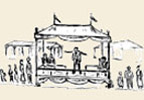|
Men of Good Faith
Dr. Max Landsbery, rabbi
of Temple
B'rith Kodesh, and
Dr. Asa W. Saxe,
pastor of the First Universalist Church in Rochester
by
Role Models — However much we'd like to see
it, there's not enough good old fashioned love, understanding and cooperation
in our world
today. Reviewing history's dusty
pages does, none the less, provide us with one remarkable tale of good faith.
The men involved were both religious leaders, one a rabbi, the other a pastor.
Both had excellent educations, large and devout congregations, were the center
of controversy and were influential members in the Rochester community.
The Rabbi— First, an introduction to the good
rabbi. He was Dr. Max Landsbery, who came directly from Berlin to Rochester
in 1871. He became the rabbi for Temple B'rith
Kodesh (Holy Covenant) and as their spiritual leader represented a far different
point of view than his more Orthodox Jewish co-religionists. The brilliant
Dr. Landsbery soon become famous, and as more refugees from Europe's revolutions
found their way to Rochester, his congregation grew. Soon the city became
known as the center for Reform Judaism. His temple, the oldest synagogue in
our city, was located at 177 Gibbs Street at the corner of Grove Street. Of
note is the fact that in 1883 Dr. Landsbery introduced his congregation to "a
new ritual almost entirely in English." It was believed to be the first Temple
in the world to experience such an innovation.
Of particular concern to the Rabbi was the plight of the many who labored
in environments far from satisfactory. Women working long hours in sweat-shop
conditions and the employment of children in factory situations were condemned
by Dr. Landsberg along with many other liberal Rochesterians. In 1902 he worked
especially hard with Mayor Carnahan, Joseph T. Alling and others on a
local committee to abolish child labor.
His charming wife, too, became an integral part of Rochester's social gatherings and served on many committees devoted to improving working conditions for women. Perhaps at no time prior to this was a religious couple made to feel more welcome.
The Reverend — Our second religious leader is the kind reverend. He was Asa
W. Saxe, D. D., pastor of the First Universalist Church. He was only the second
pastor to guide
the congregation having succeeded Rev. Dr. G. W. Montgomery in 1854. At that
time the church, located on South Clinton Avenue where Midtown Plaza now stands,
was only 8 years old. Like the good rabbi, the reverend also represented
an outlook far too liberal for his fellow religous leaders.
Friendship — The two men of faith, each with very diverse backgrounds, found
that they truly had much in common. We are unsure of how they chanced to meet,
although
they both shared center-city houses of worship. We do know they were warm friends
for over 35 years. They were often seen deep in discussion both theological
as well as mundane. As men of the cloth they provided inspiration for each
other sharing mutual concerns for the temporal as well as the eternal welfare
of their fellow man.
In Dr. Landsberg's words in referring to Dr. Saxe: "He and his sainted wife
were first to greet me when a stranger on these shores." He welcomed me saying, "How
I delight to hear you stand for the fatherhood of God and the brotherhood of
man! For years you have suffered from prejudice and persecution. We have suffered,
too. The Jewish religion was and is the corner stone of Christianity and the
day will come when it will be acknowledged that it is the corner stone of
all religions."
An Act of Faith — When a fire struck the Temple
B'rith Kodesh Synagogue, Rabbi Landsberg was distraught and unable to find
an alternate place to worship.
To his great relief and even greater pleasure his prayers were answered. He
was approached by Reverend Saxe who explained that the Universalist Church
would open its doors to the Jewish faithful on Saturdays. This would cause
little problem for the Universalist congregation who worshipped on Sundays.
The proposal was a simple act of faith and was gratefully accepted.
Returning the Favor — In 1907 a communication was sent to the Universalists
of our city with a most unusual proposition. Real estate promoters were offering
to purchase the church
property to build a large hotel. (The Seneca/Manger) "The good Lord moves in
mysterious ways," may have been uttered by Reverend Saxe. The offer was generous
and "the genius of architect Claude Bragdon" was available if a new house
of worship were to be built.
Once the congregation made its decision to commission Bragdon and "not settle
into a suburban shelter," Dr. Saxe had another challenge to face. It was where
to relocate his flock during the construction of the new church. By now, you
may have guessed the solution. It was a gracious Dr. Landberg who suggested
to his colleague, Dr. Saxe, that the Universalists conduct their Sunday services
in Temple B'rith Kodesh. "After all," he explained, "Since we have Saturday
services, the synagogue is completely available on Sunday."
A Footnote — As an addendum to this tale it should be noted that
these two good friends also initiated the nation's first Union Thanksgiving
Service
in
1874.
This
ecumenical gathering brought together, in common worship, members from the
congregations of the Plymouth Congregational Church, Temple B'rith Kodesh and
the Universalist Church.
Thus, we see how two men of good faith actually put their words into deeds bringing together God's children and spiritually enriching the lives of all they touched.
|



